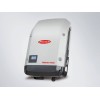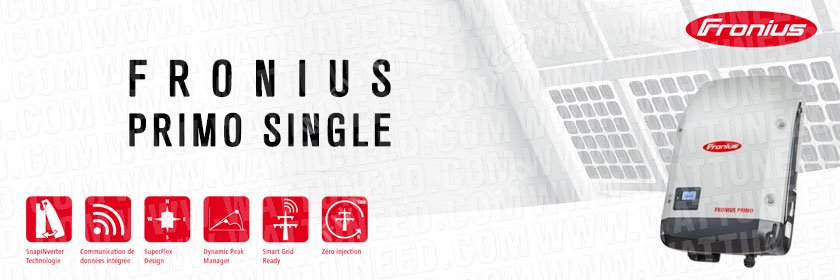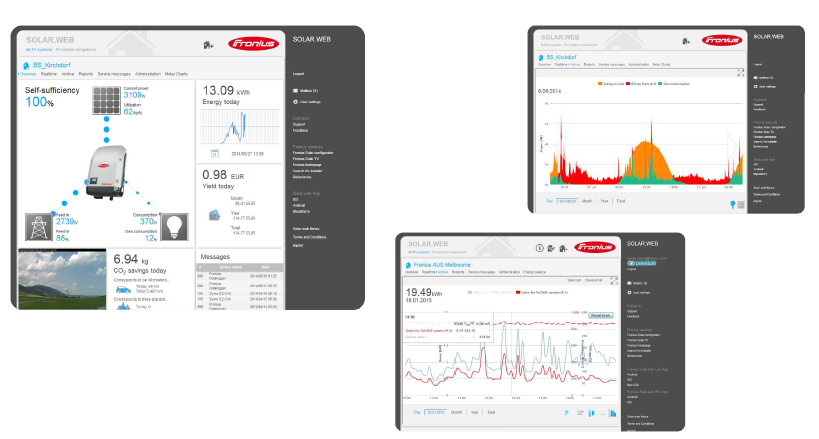
Fronius Primo 8.2-1 (2MPPT) Mono
More info

The Fronius Primo in power categories from 3.0 to 8.2 kW perfectly completes the new SnapINverter generation. This single-phase, transformerless device is the ideal inverter for private households. Its innovative SuperFlex Design provides maximum flexibility in system design, while the SnapINverter mounting system makes installation and maintenance easier than ever before. The communication package included as standard, with WLAN, energy management, several interfaces and much more besides, makes the Fronius Primo a communicative inverter for owner-occupiers
• Brand : Fronius
• Model : Primo 8.2-1
• Power : 8,2 kW
• Dimensions LxHxD : 645x431x204 mm
• Weight : 21,50 kg
• Warranty : 5 years
 SnapINverter mounting system
SnapINverter mounting system
The special feature in the design of our devices is that the connection compartment is separate from the power stage set compartment. They are installed separately. The connection area and all its cabling is fitted to the wall first. The power stage set compartment is fitted afterwards. The innovative SnapINverter mounting system makes installation and servicing extremely user-friendly. The inverter is simply placed in the wall bracket and then secured. It is not necessary to remove the entire inverter for servicing, just the power stage set compartment. All the cabling, settings and configurations remain in place.
 Integrated WLAN interface
Integrated WLAN interface
Simple, user-friendly system monitoring is very important to Fronius. With the Fronius Datamanager, we are the first inverter manufacturer to offer a WLAN interface in the inverter itself. The inverter is connected to the internet without additional cabling and grants you the perfect overview of how the PV system is operating.
 SuperFlex Design
SuperFlex Design
The Fronius SuperFlex Design combines all the system design requirements into a single inverter form. Two MPP trackers combined with a high system voltage and wide input voltage range guarantee maximum flexibility. Every DC input, and therefore every MPP tracker, is able to accommodate the entire nominal output of the inverter. The result: an inverter for every application. Thanks to the SuperFlex Design, a single inverter can cope with any challenge – including different roof orientations, shading of one or two strings, or the use of residual modules.
 Dynamic Peak Manager
Dynamic Peak Manager
The Dynamic Peak Manager is a new MPP tracking algorithm that dynamically adapts its behaviour when searching for the optimal operating point. The special feature is that the Dynamic Peak Manager automatically checks the entire characteristic curve on a regular basis and finds the global Maximum Power Point (GMPP), even in partial shade.
 Smart Grid Ready
Smart Grid Ready
Fronius inverters are ready for the Smart Grid of tomorrow. The inverters are optimally equipped to meet the technical requirements of grids in the future. A series of smart functions, known as Advanced Grid Features, are built into the devices. These include a number of control functions for optimum feed-in of reactive power and effective power. These functions are designed to enable stable grid operation even when the PV system density is very high and to prevent unwanted interruptions to feed-in and associated yield losses. Fronius inverters therefore help to guarantee the yield of a PV system.
 Zero feed-in
Zero feed-in
Today, an increasing number of grid operators in various countries are stipulating a PV power feed-in limit as a precondition before a system is connected to the grid. With dynamic power reduction, Fronius is offering a solution for optimum feed-in management. The inverter supplies the household consumers with energy first and then reduces the system output to the maximum energy feed-in permitted by the grid operator. With Fronius inverters, zero feed-in is also a possibility thanks to this function, meaning that no PV power is fed into the grid. The relevant requirements of the grid operator can be fulfilled by simply enabling a setting on the inverter's web interface.
Simple, fast and efficient assembly
* Step 1: Attach and wire without effort
BJ integrated DC *
Step 2: Place the inverter section in a few seconds !
wall bracket, lightweight (- 4kg)
Manage your production with Solar.web
Residential solutions
Setting up system monitoring using WLAN
Fronius SnapINverter commissioning checklist
Innovative SnapINverter mounting technology
Technical Data
| DONNÉES D'ENTRÉE | Fronius Primo 8.2-1 | |
|---|---|---|
| Courant d'entrée max. (Idc max1 / Idc max2) | 18,0 A / 18,0 A | |
| Courant de court-circuit max. du champ de modules (MPP1 / MPP2) | 27,0 A / 27,0 A | |
| Tension d'entrée min.(Udc min) | 80 V | |
| Tension de démarrage d'injection (Udc start) | 80 V | |
| Tension d'entrée nominale (Udc,r) | 710 V | |
| Tension d'entrée max. (Udc max) | 1.000 V | |
| Plage de tension MPP (Umpp min - Umpp max) | 270 - 800 V | |
| Nombre de trackers MPP | 2 | |
| Nombre de connecteurs DC | 2 + 2 | |
| DONNÉES DE SORTIE | ||
| Puissance nominale AC (Pac,r) | 8.200 W | |
| Puissance de sortie max. | 8.200 VA | |
| Courant de sortie AC (Iac max) | 35,7 A | |
| Couplage au réseau (plage de tension) | 1 ~ NPE 220 V / 230 V (180 V - 270 V) | |
| Fréquence (plage de fréquence) | 50 Hz / 60 Hz (45 - 65 Hz) | |
| Taux de distorsion harmonique | < 5 % | |
| Facteur de puissance(cos φac,r) | 0,85 - 1 ind. / cap. | |
| DONNÉES GÉNÉRALES | ||
| Dimensions (hauteur x largeur x profondeur) | 645 x 431 x 204 mm | |
| Poids | 21,5 kg | |
| Indice de protection | IP 65 | |
| Classe de protection | 1 | |
| Catégorie de surtension (DC / AC)1) | 2 / 3 | |
| Consommation nocturne | < 1 W | |
| Concept d’onduleur | Sans transformateur | |
| Refroidissement | Refroidissement par air régulé | |
| Montage | Montage intérieur et extérieur | |
| Plage de température ambiante | -40 °C - +55 °C | |
| Humidité de l'air admise | 0 % - 100 % | |
| Hauteur max. au-dessus du niveau de la mer | 4.000 m | |
| Technologie de raccordement DC | 2x DC+1, 2x DC+2 et 4x DC- bornes à vis 2,5 - 16 mm² | |
| Technologie de raccordement AC | Bornes à vis AC 2,5 - 16 mm² 3 pôles | |
| Certificats et conformité aux normes | DIN V VDE 0126-1-1/A1, CEI 62109-1/-2, CEI 62116, CEI 61727, AS 4777-2, AS 4777-3, G83/2, G59/3, CEI 0-21. | |
| RENDEMENT | ||
| Rendement max. | 98,1 % | |
| Rendement européen (ηEU) | 97,5 % | |
| η à 5 % Pac,r2) | 85,5 / 89,6 / 88,5 % | |
| η à 10 % Pac,r2) | 92,2 / 96,0 / 94,8 % | |
| η à 20 % Pac,r2) | 94,9 / 97,4 / 97,2 % | |
| η à 25 % Pac,r2) | 95,5 / 97,7 / 97,6 % | |
| η à 30 % Pac,r2) | 95,8 / 97,9 / 97,7 % | |
| η à 50 % Pac,r2) | 96,3 / 98,0 / 98,0 % | |
| η à 75 % Pac,r2) | 96,3 / 98,1 / 97,9 % | |
| η à 100 % Pac,r2) | 96,2 / 97,7 / 97,7 % | |
| Rendement MPP | > 99,9 % | |
| DISPOSITIFS DE PROTECTION | ||
| Mesure d'isolation DC | Oui | |
| Capacité de surcharge | Déplacement du point de fonctionnement dynamique, limitation de puissance | |
| Sectionneur DC | Oui | |
| INTERFACES | ||
| WiFi / Ethernet LAN | Fronius Solar.web, Modbus TCP SunSpec, Fronius Solar API (JSON) | |
| 6 entrées et 4 entrées-sorties numériques | Connexion au dispositif d'échange d'informations d'exploitation | |
| USB (connecteur de type A)3) | Datalogging, mise à jour de l'onduleur par clé USB | |
| 2 x RS422 (connecteur RJ45)3) | Fronius Solar Net | |
| Sortie de signalisation3) | Gestion de l'énergie (sortie relais à potentiel zéro) | |
| Datalogger et serveur Web | Intégré | |
| Datalogger et serveur Web3) | Connexion compteur S0 / entrée protection contre la surtension | |
| RS485 | Modbus RTU SunSpec ou raccordement au compteur | |
1) Selon la norme CEI 62109-1.
2) Et pour Umpp min / Udc,r / Umpp max
3) Également disponible dans la version light..
Sous réserve de modifications.
Data sheets and documentation
Specifications
| 1000 V | |
| 8200 VA | |
| Monophasé | |
| 2 MPPT |

















